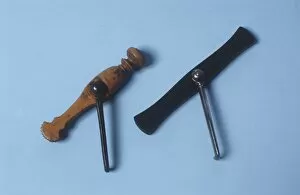Tooth Drawing Collection
"Unveiling the Fascinating World of Tooth Drawing
All Professionally Made to Order for Quick Shipping
"Unveiling the Fascinating World of Tooth Drawing: A Journey through Historical Dental Instruments" Step back in time and explore the intriguing world with a collection of historical dental instruments. From ancient tools used for lithotomy and trepanning to 19th-century tooth keys, these artifacts provide a glimpse into the evolution of dentistry. Among the remarkable pieces is a set of six tooth keys from the 19th century, showcasing the ingenuity behind extracting teeth during that era. Another set, dating back to circa 1850, features three tooth keys that were instrumental in alleviating dental discomfort. Delving further into history, we encounter a dental elevator from around 1830. This innovative instrument was designed to elevate teeth gently and facilitate their removal. Nearby lies a dental hygiene set from approximately 1820—a testament to early efforts towards oral care. One cannot help but marvel at a three-clawed tooth key hailing from circa 1800. Its intricate design demonstrates how dentists adapted tools to suit their patients' needs. Similarly, a mechanical tooth key crafted around 1850 showcases advancements in dental technology during this period. Venturing even deeper into antiquity reveals an astonishing find—a dental pincer dating all the way back to circa 1680. Imagine its use in extracting teeth centuries ago—an art form perfected over time. The collection also boasts unique items such as a pelican tooth extractor crafted around 1750—an instrument whose mechanism resembles that of its namesake bird—symbolizing precision and delicacy combined. A double-ended tooth key from the nineteenth century stands out for its versatility—offering multiple options for extraction techniques depending on individual cases. And let's not forget another exquisite specimen—a beautifully preserved tooth key originating from approximately1820—showcasing both functionality and craftsmanship. As we conclude our journey through these captivating artifacts, one thing becomes clear—the art of "tooth drawing" has come a long way.














